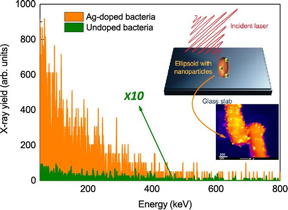Home > Press > Nanospiked bacteria are the brightest hard X-ray emitters
 |
| This image shows a 10,000 fold enhanced X-ray emission from nanoparticle doped bacteria, from plasma generated by intense ultra short infrared pulses. CREDIT: Tata Institute of Fundamental Research |
Abstract:
In a step that overturns traditional assumptions and practice, researchers at the Tata Institute of Fundamental Research, Mumbai and Institute for Plasma Research, Gandhi Nagar have fashioned bacteria to emit intense, hard x-ray radiation.
Nanospiked bacteria are the brightest hard X-ray emitters
Mumbai, India | Posted on July 2nd, 2015When one thinks of hard x-rays and bacteria it is usually that the bacteria are at the receiving end of the x-ray source - being imaged, irradiated for some modification or simply assessed for radiation damage. One hardly thinks of using bacteria as a source of x-rays, far from turning them into the brightest among such sources.
The experiment consists of a femtosecond, infrared, high intensity laser irradiating a glass slide coated with E. coli bacterial cells, turning the cell material into a hot, dense plasma. Laser driven plasmas have been known to be very useful table top x-ray sources and efforts are constantly being made to improve their brightness. One such effort, an important one, has been to create plasmas on a nanostructured surface where the nanostructure amplifies the incident intensity by electromagnetic local field enhancement. The present advance has been made possible by the insight the researchers had when they realized that natural micro and nanostructures in the bacteria can be readily used for such intensity enhancement leading to hotter, brighter plasma. They showed that the bacterial cells increased the x-ray flux by a factor of 100 in the 50 - 300 keV x-ray region [1]. Further they grow the bacterial cells in a silver chloride solution whereby the silver atoms aggregated as nanoparticles inside the cell. They could then use these bacteria spiked with nanoparticles to boost the emission another 100 times, leading to an overall enhancement of 10,000 times from the flux emitted by plain glass slides without the bacterial coating [1]. This is the highest conversion of laser light to hard x-rays ever achieved.
This lateral stride could potentially lead to biologically inspired plasma physics and high energy density science with myriad applications among novel particle sources, creation of extreme excited states and related areas.
[1] Enhanced x-ray emission from nano-particle doped bacteria, Krishnamurthy et.al., Opt. Exp. (2015); ibid Opt. Exp. 20, 5754-5761 (2012).
####
For more information, please click here
Contacts:
M Krishnamurthy
91-850-002-7747
Copyright © Tata Institute of Fundamental Research
If you have a comment, please Contact us.Issuers of news releases, not 7th Wave, Inc. or Nanotechnology Now, are solely responsible for the accuracy of the content.
| Related News Press |
News and information
![]() Researchers develop molecular qubits that communicate at telecom frequencies October 3rd, 2025
Researchers develop molecular qubits that communicate at telecom frequencies October 3rd, 2025
![]() Next-generation quantum communication October 3rd, 2025
Next-generation quantum communication October 3rd, 2025
![]() "Nanoreactor" cage uses visible light for catalytic and ultra-selective cross-cycloadditions October 3rd, 2025
"Nanoreactor" cage uses visible light for catalytic and ultra-selective cross-cycloadditions October 3rd, 2025
Physics
![]() Quantum computers simulate fundamental physics: shedding light on the building blocks of nature June 6th, 2025
Quantum computers simulate fundamental physics: shedding light on the building blocks of nature June 6th, 2025
![]() A 1960s idea inspires NBI researchers to study hitherto inaccessible quantum states June 6th, 2025
A 1960s idea inspires NBI researchers to study hitherto inaccessible quantum states June 6th, 2025
![]() Magnetism in new exotic material opens the way for robust quantum computers June 4th, 2025
Magnetism in new exotic material opens the way for robust quantum computers June 4th, 2025
Discoveries
![]() Researchers develop molecular qubits that communicate at telecom frequencies October 3rd, 2025
Researchers develop molecular qubits that communicate at telecom frequencies October 3rd, 2025
![]() Next-generation quantum communication October 3rd, 2025
Next-generation quantum communication October 3rd, 2025
![]() "Nanoreactor" cage uses visible light for catalytic and ultra-selective cross-cycloadditions October 3rd, 2025
"Nanoreactor" cage uses visible light for catalytic and ultra-selective cross-cycloadditions October 3rd, 2025
Announcements
![]() Rice membrane extracts lithium from brines with greater speed, less waste October 3rd, 2025
Rice membrane extracts lithium from brines with greater speed, less waste October 3rd, 2025
![]() Researchers develop molecular qubits that communicate at telecom frequencies October 3rd, 2025
Researchers develop molecular qubits that communicate at telecom frequencies October 3rd, 2025
![]() Next-generation quantum communication October 3rd, 2025
Next-generation quantum communication October 3rd, 2025
![]() "Nanoreactor" cage uses visible light for catalytic and ultra-selective cross-cycloadditions October 3rd, 2025
"Nanoreactor" cage uses visible light for catalytic and ultra-selective cross-cycloadditions October 3rd, 2025
Interviews/Book Reviews/Essays/Reports/Podcasts/Journals/White papers/Posters
![]() Spinel-type sulfide semiconductors to operate the next-generation LEDs and solar cells For solar-cell absorbers and green-LED source October 3rd, 2025
Spinel-type sulfide semiconductors to operate the next-generation LEDs and solar cells For solar-cell absorbers and green-LED source October 3rd, 2025
![]() Rice membrane extracts lithium from brines with greater speed, less waste October 3rd, 2025
Rice membrane extracts lithium from brines with greater speed, less waste October 3rd, 2025
|
|
||
|
|
||
| The latest news from around the world, FREE | ||
|
|
||
|
|
||
| Premium Products | ||
|
|
||
|
Only the news you want to read!
Learn More |
||
|
|
||
|
Full-service, expert consulting
Learn More |
||
|
|
||








